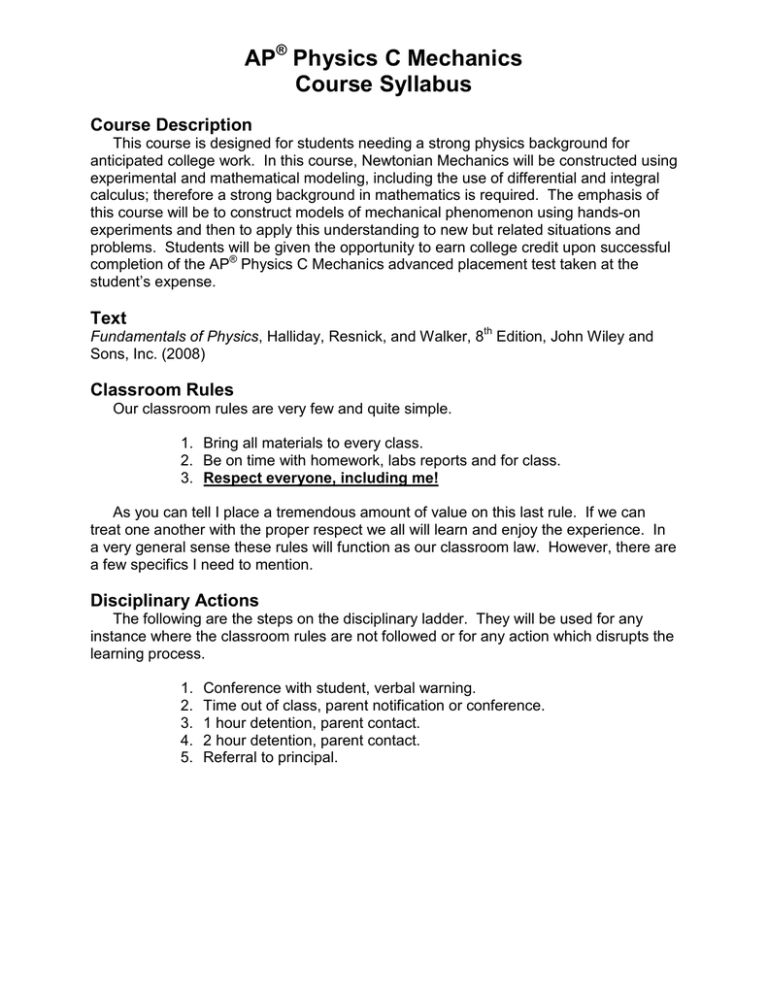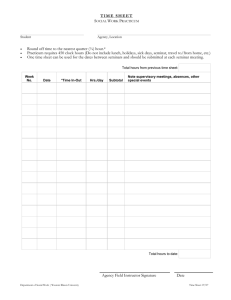AP Physics C Mechanics Course Syllabus Course Description
advertisement

AP® Physics C Mechanics Course Syllabus Course Description This course is designed for students needing a strong physics background for anticipated college work. In this course, Newtonian Mechanics will be constructed using experimental and mathematical modeling, including the use of differential and integral calculus; therefore a strong background in mathematics is required. The emphasis of this course will be to construct models of mechanical phenomenon using hands-on experiments and then to apply this understanding to new but related situations and problems. Students will be given the opportunity to earn college credit upon successful completion of the AP® Physics C Mechanics advanced placement test taken at the student’s expense. Text Fundamentals of Physics, Halliday, Resnick, and Walker, 8th Edition, John Wiley and Sons, Inc. (2008) Classroom Rules Our classroom rules are very few and quite simple. 1. Bring all materials to every class. 2. Be on time with homework, labs reports and for class. 3. Respect everyone, including me! As you can tell I place a tremendous amount of value on this last rule. If we can treat one another with the proper respect we all will learn and enjoy the experience. In a very general sense these rules will function as our classroom law. However, there are a few specifics I need to mention. Disciplinary Actions The following are the steps on the disciplinary ladder. They will be used for any instance where the classroom rules are not followed or for any action which disrupts the learning process. 1. 2. 3. 4. 5. Conference with student, verbal warning. Time out of class, parent notification or conference. 1 hour detention, parent contact. 2 hour detention, parent contact. Referral to principal. AP® Physics C Mechanics Course Syllabus page 2 Mechanics Outline Most units begin with a demonstration of a particular mechanics phenomenon, followed by a brainstorming session in which variables pertinent to the situation are developed. Next, the equipment needed to measure the variables and the experimental techniques for controlling the variables are discussed. Students then do the experiment and construct the relationships between the variables both graphically and mathematically. These models are then deployed through further activities and examples so that the students can solve related problems. Overall, experiments and hands-on activities comprise more than 20% of the course. All labs will culminate in a detailed lab report. One Dimensional Motion Topic Constant Velocity Motion Uniformly Accelerated Motion Labs and Activities Car Crash Practicum – Students will determine where two constant velocity cars will crash Catch the Car Practicum – Students will determine where a uniformly accelerated car will catch a constant velocity car Motion with non-constant acceleration including the use of basic derivatives and integrals. Vectors and Newton’s Laws Topic Vectors - including the addition and subtraction of vectors in up to three dimensions. Labs and Activities Vector Practicum I – Students will gain experience in adding vector quantities experimentally and computationally using a force table Vector Practicum II – Students will gain experience in adding three (3) vector quantities experimentally and computationally using a force table Newton’s First Law Dynamics Practicum I – Students will determine the unknown mass of an object hanging in equilibrium Newton’s Second and Third Laws Dynamics Practicum II – Students will determine the unknown mass of an object hanging from an Atwood’s Machine AP® Physics C Mechanics Course Syllabus page 3 Two and Three Dimensional Motion Topic Projectile Motion Uniform Circular Motion General Two and Three Dimensional Motion including the use of derivatives and integrals Labs and Activities Projectile Practicum - Students will determine where to place a can using height vs. range data Energy Topic The Law of Conservation of Energy Energy Storage Mechanisms Work by both constant and variable forces including the use of the dot product and integrals General Potential Energy Functions including their graphs using both differential and integral calculus Power Labs and Activities Energy Practicum – Students will determine where to release a mass on a spring so that it will just touch an egg without breaking it Momentum Topic The Law of Conservation of Momentum Impulse and the Change in Momentum Labs and Activities Momentum Practicum – Students will determine where to place a can to catch a ball by measuring a collision between the projectile and a cart AP® Physics C Mechanics Course Syllabus page 4 Rotation Topic Rotational Kinematics Rotational Dynamics including rotational inertia and torques Rotational Energy and Rolling The Conservation of Angular Momentum Labs and Activities Angular Position Lab – Students will determine the relationship between the arc length and the radius and thereby define the angular position. Turning Effect – Students will investigate the relationship between the turning effect, the force and the lever arm Rotational Newton’s Second Law Lab – Students will discover the rotational version of Newton’s Second Law Rotational Inertia of Point Masses – Students will investigate the relationship between the rotational inertia of two point masses, their mass and their positions Parallel-Axis Theorem Lab – Students will investigate the relationship between the rotational inertia of a body of mass M around a parallel axis of rotation not through the center of mass and the distance h from the center of mass to that parallel axis Rolling Practicum – Students will attempt to land a rolling ball into a can using only basic measurements Conservation of Angular Momentum Demonstration – The teacher will lead the students through an investigation of the Law of Conservation of Angular Momentum AP® Physics C Mechanics Course Syllabus page 5 Oscillations Topic Simple Harmonic Motion Mass on a Spring Energy in SHM Torsion Pendulum Simple Pendulum Physical Pendulum Labs and Activities Simple Harmonic Motion Activity – Students will investigate the motion of a mass oscillating on the end of a spring Period of a Mass on a Spring Lab – Students will investigate the relationship between the period, the mass and the spring constant of a mass on a spring Energy in SHM Activity – Students will investigate the energy of a simple harmonic oscillator using a mass on a spring Torsion Pendulum Demonstration – The teacher will lead the students through an investigation of a torsion pendulum Simple Pendulum Lab – Students will investigate the relationship between the period, mass, length, amplitude, and gravitational field strength of a simple pendulum Physical Pendulum Demonstration – The teacher will lead the students through an investigation of a physical pendulum Gravitation Topic Kepler’s Three Laws Newton’s Law of Universal Gravitation Energy Satellites and Orbits Tests There will be around one test every two - three weeks. Tests will consist of multiple choice questions and free response problems. We will have a review or at least a practicum the day before a test. In case of absence, the following rules apply: 1. If the absence occurs on the review day only, you will be required to take the test on the regular testing day. 2. If the absence occurs on the day of an announced test only, you will be required to take the test on your first day back. 3. Any other instance will be handled at my discretion. AP® Physics C Mechanics Course Syllabus page 6 Homework A few daily problems and worksheets will be assigned. They will be due at the beginning of the next day. All worksheets are worth four (4) points based upon the following scale: 4 points 2 points 0 points - Worksheet done at the beginning of the next class. Worksheet is not done at the beginning of the next class, but is finished at the time of the test over that unit. Worksheet is not done at the time of the test over that unit. Classroom Materials Physics Book Pen or pencil, pencil preferred Three–ring binder for your notes, worksheets, labs, and other materials A scientific calculator is highly recommended unless you can do decimals and trigonometric functions in your head All of these materials should be brought every day. If any of these materials is difficult for you to obtain, please see me and I will get you what you need. Grades At Hartland High School we are trying to bring more consistency and accuracy to the academic marks that we provide for students. This year, teachers are using in the 4-point scale, which is consistent with GPA scales. How it Works: In class, students will be graded on the following scale: 4.0 – A 3.7 – A3.3 – B+ 3.0 – B 2.7 – B2.3 – C+ 2.0 – C 1.7 – C1.3 – D+ 1.0 – D 0.7 – D0.3 – E 0.0 – No Attempt In MiSTAR, you will notice that all grades are represented by a number as shown above. These numbers represent the grade that the student received on the assignment.




